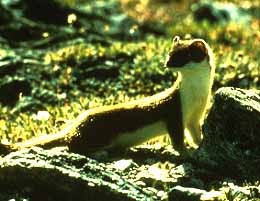|
| 질의: Gopher snake | 결과: 16번째/17 | |
Long-tailed Weasel (Mustela frenata) (긴꼬리족제비(북미,중미)) - Wiki
| 제목: | Long-tailed Weasel (Mustela frenata) (긴꼬리족제비(북미,중미)) - Wiki
| |

| 해상도: 260x201
파일크기: 16944 Bytes
등록시간: 2006:10:26 01:02:03
|
[Photo] North American Longtail Weasel. From U.S. National Park Service http://www.nps.gov/yell/kidstuff/Alphabet/l.htm
Long-tailed Weasel
From Wikipedia, the free encyclopedia
The Long-tailed Weasel (Mustela frenata) is the most widely distributed mustelid in the New World. Its range extends from southern Canada through most of the United States to Mexico, Central America and the northern parts of South America. It is generally found in open or semi-open habitats near water.
From Enature.com: "Like other weasels, the Long-tailed was once thought to be strictly nocturnal, but in fact is often out by day, since voles, a primary food item, are mainly diurnal. The most widespread carnivore in the Western Hemisphere, it preys largely on mice and voles, while also taking rabbits, chipmunks, shrews, rats, birds, and poultry, and the occasional insect or earthworm. When hunting, it follows a zigzag pattern, moving from burrow to burrow. It does not suck blood, contrary to myth, although it will often lap it from a wound. The Long-tailed Weasel will attack animals its own size and larger, but is very careful to attempt to take larger prey only when opportunity presents itself, or when smaller quarry is scarce. When attacking, the weasel rushes in toward the prey, grabs the victim at the base of the skull, and curls its body around it while grasping it with its forelimbs. It eats the head and thorax first, and caches the portion not eaten. Weasels occasionally go on killing sprees, as instinct dictates that they procure food when available and then store it. For this reason, a weasel in a chicken yard is disastrous. Like other weasels, the Long-tailed runs by a series of bounds, with its back humped at each bound and its tail trailing backward. It makes its dens in the abandoned burrows of other mammals, often chipmunks, and also ground squirrels, moles, or pocket gophers. Within the den it constructs a nest, primarily of hair from prey. The maternity den may also be in the burrow of another small mammal, or under a stump in a gully. The Long-tailed Weasel uses a variety of vocalizations: It may screech and squeal, utter a rapid trill, and purr when content. During the mating season, females give a reedy, twittering call. When the animal is alarmed, enraged, or excited by the mating urge, the anal glands release a powerful malodorous musk. A weasel may drag its rump on the ground, presumably to leave a scent that informs other weasels of its sex and perhaps even its identity. The Long-tailed Weasel male matures during its second summer, the female at three to four months of age. Only the female brings food to the young, which disperse at seven to eight weeks, when the males are already larger than their mother. In the northern part of its range, the Long-tailed Weasel turns white in winter. The time of the molt is governed by the length of daylight, and the change is gradual; weasels are piebald during transition. In the southern part of its range, within a 600-mile-wide (1,000-km-wide) transcontinental belt, some individuals molt to white, while others remain brown. In Pennsylvania, for instance, less than half of the weasels become white, and south of the Maryland-Pennsylvania border none do. The color change is evidently genetically determined: If a northern weasel is captured and taken south, it will still turn white in winter, while a southern weasel transported north will remain brown. Weasels are valuable in controlling populations of rodents, including rats. Hawks, owls, cats, foxes, and snakes prey upon the Long-tailed Weasel. This animal has also been taken by trappers, although its pelt is not considered especially valuable."
http://en.wikipedia.org/wiki/Long-tailed_weasel
| The text in this page is based on the copyrighted Wikipedia article shown in above URL. It is used under the GNU Free Documentation License. You may redistribute it, verbatim or modified, providing that you comply with the terms of the GFDL. |
|
댓글 |
|---|
| | 손님 |
|
Scientific Name: Mustela frenata Lichtenstein, 1831
Common Names:
English – Long-tailed Weasel, Bridled Weasel, Big Stoat
Spanish – Comedreja Andina, Comadreja cola larga
French – belette à longue queue |
^o^
동물그림창고 똑똑전화 누리집
^o^
|
|
|